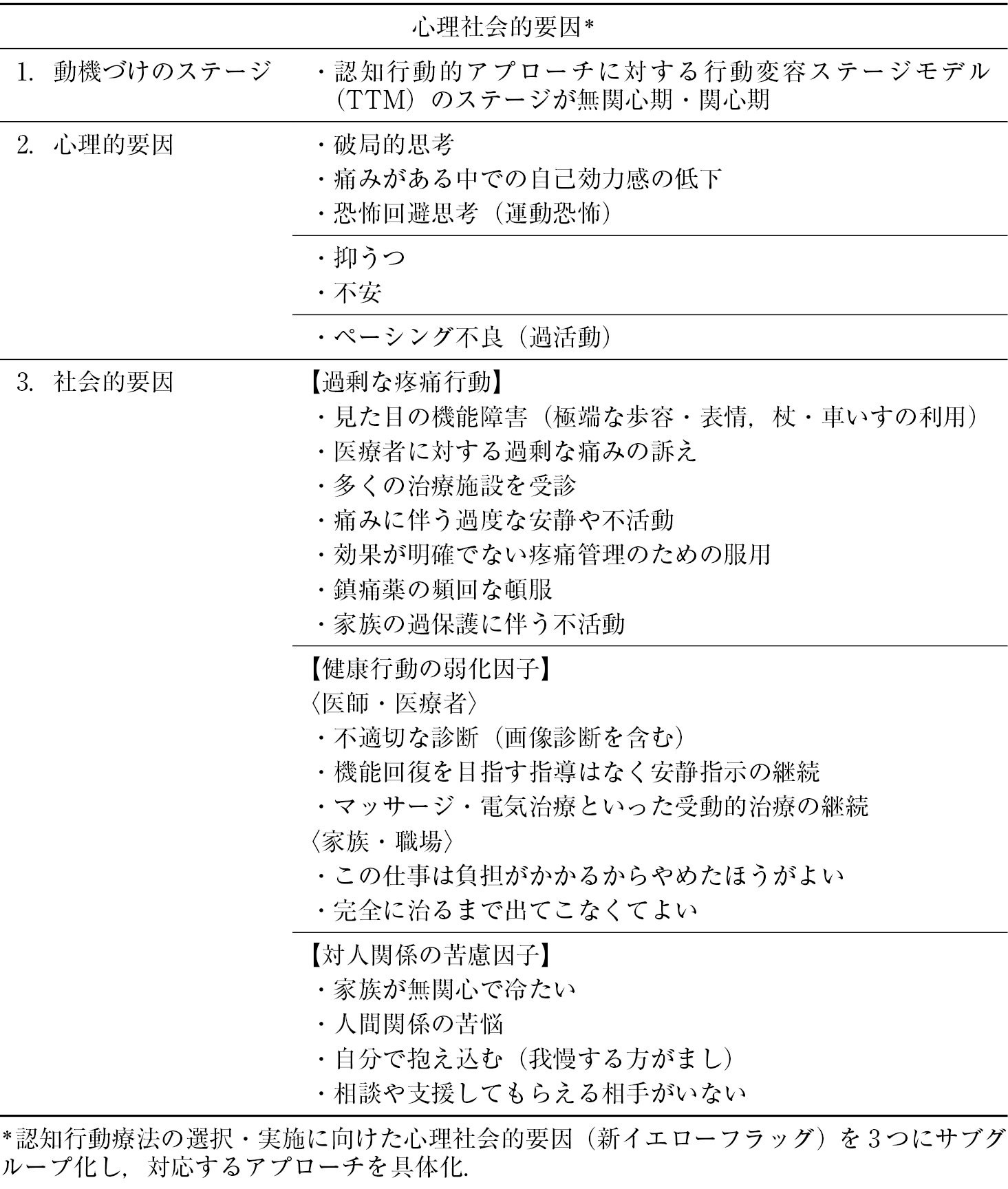2 0 0 0 OA 気象関連性疼痛を訴える慢性疼痛患者の特徴と運動療法
- 著者
- 櫻井 博紀 佐藤 純一 青野 修一 新井 健一 井上 真輔 西原 真理 畠山 登 尾張 慶子 西須 大徳 牧野 泉 牛田 享宏
- 出版者
- 日本疼痛学会
- 雑誌
- PAIN RESEARCH (ISSN:09158588)
- 巻号頁・発行日
- vol.34, no.4, pp.336-341, 2019-12-20 (Released:2020-03-14)
- 参考文献数
- 19
Patients who complain of chronic pain have various symptoms and complicated pathologies, and there are often cases in which the symptoms worsen due to weather changes. However, few studies have examined the nature of pain affected by weather changes. In this time, we investigated the characteristics of patients with weather–related pain. As results, their pain intensity is moderate and they can maintain moderate daily activity. But in psychosocial factors, they have low self–efficacy and high catastrophic thinking. As treatment for chronic pain, exercise therapy managed by a therapist is highly recommended in non–drug therapy. Patients with weather–related pain often complain at head and neck shoulders. Evidences on the effects of exercise therapy for these body parts have also been reported. We hope that capturing the characteristics of patients with weather–related pain will lead to more appropriate treatments tailored to the pathological condition of the patients.
1 0 0 0 OA 慢性腰痛に対する集学的治療のための新心理社会的フラッグシステム
- 著者
- 松平 浩 笠原 諭 酒井 美枝 井上 真輔 鉄永 倫子 高橋 紀代 高槻 梢 二瓶 健司 矢吹 省司 髙橋 直人
- 出版者
- 一般社団法人 日本脊椎脊髄病学会
- 雑誌
- Journal of Spine Research (ISSN:18847137)
- 巻号頁・発行日
- vol.14, no.6, pp.858-868, 2023-06-20 (Released:2023-06-20)
- 参考文献数
- 12
慢性非特異的腰痛患者には,心理社会的要因が関与している症例が多く,その場合はそれらの要因を的確に評価し,それに応じた適切かつ合理的な認知行動的アプローチが求められる.就労に支障をきたしている患者に対しては,社会的支援も必要である.これらと運動療法を併せることが主軸といえる慢性腰痛に対する集学的治療は,本邦の慢性疼痛診療ガイドラインにおいて最高位の“施行することを強く推奨する”1A判定である.一方,筋骨格系疼痛に対する「心理社会的フラッグシステム」が,世界の有識者による会議を経て英国で開発され,欧州では各国の診療ガイドラインで推奨されている.我々は,令和3年度厚生労働省慢性の痛み政策研究事業(慢性の痛み患者への就労支援/仕事と治療の両立支援および労働生産性の向上に寄与するマニュアルの開発と普及・啓発)の中で,意欲ある治療者のOperation Systemとなる合理的な手法を目指した「新心理社会的フラッグシステム日本版」を開発した.本稿では,心理社会的要因であるイエローフラッグ(認知行動療法の選択・実施に向けた心理社会的要因と具体的なアプローチ)を中心に解説する.
- 著者
- 河合 隆志 牛田 享宏 井上 真輔 池本 竜則 新井 健一 西原 真理
- 出版者
- 日本疼痛学会
- 雑誌
- PAIN RESEARCH (ISSN:09158588)
- 巻号頁・発行日
- vol.29, no.3, pp.181-189, 2014-08-30 (Released:2014-09-16)
- 参考文献数
- 20
Many patients have neck and back pain, and their standing posture (spinal alignment) is sometimes considered to be one of the factors that contributes to such pain. Thus, it would be useful to evaluate spinal loads in that posture. A method to evaluate individual spinal loads using link segment models made from body mass distributions using DXA (dual–energy X–ray absorptiometry) was developed. An element was defined as 1.30 × 1.22 cm, and a detailed body mass distribution consisting of 7473 elements was constructed using DXA equipment (QDR4500). The subjects' bodies were divided into cervicofacial (vertex–C7 ⁄ T1), thoracic (C7 ⁄ T1 – T12 ⁄ L1), and lumbar (T12 ⁄ L1 – L4 ⁄ 5) segments. Each mass, M1, M2, and M3, and the center of the masses were calculated. With these parameters and DXA images, each torque, TC7/T1, TT12/L1, and TL4/5, was calculated from the following formulas: TC7/T1 = M1gr1cosθ1, TT12/L1 = M1g (l2cosθ2 + r1cosθ1) + M2gr2cosθ2, and TL4/5 = M1g (l3cosθ3 + l2cosθ2 + r1cosθ1) + M2g (l3cosθ3 + r2cosθ2) + M3gr3cosθ3 (r1, r2, and r3: lengths from the rotation center to each center of mass; l2 and l3: lengths of C7 ⁄ T1 – T12 ⁄ L1 and T12 ⁄ L1 – L4 ⁄ 5; θ1, θ2, and θ3: angles formed between a horizontal line and r1, r2, and r3). In order to reproduce the standing posture on DXA, the standing side was formed by a vacuum cushion for operative position in advance. The parameters from DXA in the lateral view were as follows. In case 1 (38–year–old man, healthy, 164.0 cm and 55.5 kg), they were M1 = 4.50, M2 = 13.24, M3 = 6.92 kg, TC7/T1 = –0.28, TT12/L1 = –3.80, and TL4/5 = –6.42 Nm (facing right, clockwise: positive). In case 2 (76–year–old man, lumbar spondylosis, 156.9 cm and 59.6 kg), they were M1 = 4.83, M2 = 14.27, M3 = 10.34 kg, TC7/T1 = –1.69, TT12/L1 = –16.1, and TL4/5 = –44.3 Nm. In case 3 (71–year–old woman, lumbar spondylosis, scoliosis, 147.2 cm and 49.0 kg), they were M1 = 4.63, M2 = 11.42, M3 = 5.36 kg, TC7/T1 = –2.53, TT12/L1 = –16.0, and TL4/5 = –27.0 Nm. Torques at L4/5 were 6.9 and 4.2 times greater in cases 2 and 3 than in case 1. Total masses calculated from DXA were 54.5, 59.0, and 47.6 kg, and errors between these and actual weights were –1.8, –1.0, and –2.9%, respectively. A method for evaluating spinal loads as torques was developed using DXA. In the future, it will be possible to use this method to evaluate factors such as pain and the effect of rehabilitation. The relationships between torques and various scales (such as pain, depression, ADL, and QOL) need to be examined, taking into account age, sex, muscular strength, etc.
1 0 0 0 OA カキ'西条'におけるストレス誘導エチレン生合成と果実軟化
- 著者
- 中野 龍平 播磨 真志 小倉 恵実 井上 真輔 久保 康隆 稲葉 昭次
- 出版者
- 園芸学会
- 雑誌
- 園芸学会雑誌 (ISSN:00137626)
- 巻号頁・発行日
- vol.70, no.5, pp.581-585, 2001-09-15
- 参考文献数
- 23
- 被引用文献数
- 15 27
カキ'西条'果実の軟化に対するエチレンの関与を明らかにするとともに, 果実のエチレン生合成に及ぼすCTSD脱渋に相当するCO_2処理と貯蔵中の湿度条件の影響を調査した.'西条'果実を>95%CO_2で16時間処理した後, 温度20℃湿度40∿60%の条件下で貯蔵すると, 収穫後2日(CO_2処理後1日)よりエチレン生成が検出され, 収穫後5日より軟化果実が多発した.1-methylcyclopropene(MCP)によりエチレンの作用を阻害すると, この急激な軟化は完全に抑えられた.CO_2処理を行わずに, 果実を低湿度下(40∿60%)および高湿度下(>95%)で貯蔵すると, 低湿度下で貯蔵した果実では収穫後2日よりエチレン生成の誘導と急激な軟化が観察された.高湿度下で貯蔵した果実ではエチレン生成・軟化発生とも収穫後10日まで抑えられた.一方, CO_2処理果実では, 高湿度下で貯蔵した場合でも収穫後2日よりエチレン生成とそれに伴う急激な軟化がみられた.以上より, '西条'果実の収穫後の軟化には, 水ストレスおよび脱渋処理に伴うCO_2ストレスによって誘導されるエチレンが関与していることが示された.

